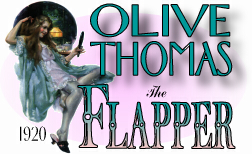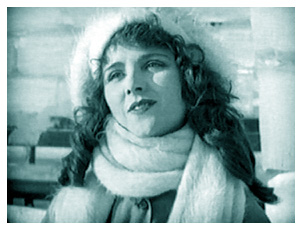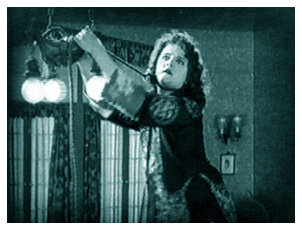

Selznick Pictures
CAST: Olive Thomas (Genevieve "Ginger" King), Theodore Westman, Jr. (Bill Forbes), Wm. P. Carlton, Jr. (Richard Channing), Warren Cook (Senator King), Katherine Johnson (Hortense), Arthur Johnson (Tom Morran), Frances Marshall (Elmira Buttons), Marcia Harris (Miss Paddles)
Ginger lives in Orange Springs, Florida, a town where having
a soda with a boy is considered scandalous. She is sent to boarding
school and falls for a handsome older man, Richard Channing. She
gets in trouble with the headmistress when she sneaks out to the
local country club where Channing is having a party. One of her
schoolmates tells on her, but her motive is to get the headmistress
out of the way so she can rob the school's safe and sneak away
with her crooked boyfriend. Based on a  vague
note, Ginger goes to a hotel in New York on her way home from
school where the former schoolmate and her boyfriend are. They
force her to take the suitcases containing the valuables, which
include fancy clothes and jewels, with her to Orange Springs.
Knowing that Channing has gone to Orange Springs on a yachting
trip, Ginger decides to use the clothes and jewels and pretend
to be a woman of the world when she goes home. The plan backfires,
and her father believes she is lying about it being a joke, detectives
show up wanting to know why she has stolen loot, and both her
young admirer, Bill, and Channing think she has really become
a wicked woman.
vague
note, Ginger goes to a hotel in New York on her way home from
school where the former schoolmate and her boyfriend are. They
force her to take the suitcases containing the valuables, which
include fancy clothes and jewels, with her to Orange Springs.
Knowing that Channing has gone to Orange Springs on a yachting
trip, Ginger decides to use the clothes and jewels and pretend
to be a woman of the world when she goes home. The plan backfires,
and her father believes she is lying about it being a joke, detectives
show up wanting to know why she has stolen loot, and both her
young admirer, Bill, and Channing think she has really become
a wicked woman.
Her fame was fleeting - only about five years - first as Ziegfeld Follies girl who became the "Darling of New York," and then as a film star with barely over 20 films to her credit, the last of which was released 85 years ago. None of her films were of the quality that they would have any lasting place in film history, and, only because of a recent release (2005) of "The Flapper" (1920), only two of her films have likely been seen by more than a handful of people. A few exist in archives, but most have disappeared entirely.
So why is there an interest in Olive Thomas today? The release of "The Flapper" is accompanied by a release of the Timeline Films documentary on Thomas entitled "Everybody's Sweetheart." Considering the fact that there are many more popular stars from that era, why choose Thomas for the subject of a documentary?
The fact that Thomas married Mary Pickford's brother could be part of the reason, but, odds are, very few silent movie fans can name Jack Pickford's other two wives. Maybe it's because of the mystery surrounding her death (see "The Mysterious Death of Olive Thomas" on our "Articles and Essays" page). Like the murder of director William Desmond Taylor in 1922, it's one of those intriguing subjects that continues to nag at our curiosity.
But that's too simple an explanation, and there are other deaths among those from the silent movie era that could demand as much attention, anyway (Thomas Ince, Bobby Harron, etc.). Instead, the explanation may come better by viewing one of her films such as "The Flapper" . . . that is, to watch Olive Thomas, observe her expressive features and mannerisms, delight in a charm you can't resist, absorb her lively personality, enjoy her beauty - then when the film is over, see if you don't find yourself wishing you could have known this wisp of creature who disappeared all too quickly from this world.
 "The Flapper" is an
enjoyable film with much to its credit, but it's the presence
of Olive Thomas brings it to a much higher level. Given the immense
talent of screenwriter Frances Marion (just look at her credits
from so many of the Mary Pickford films to some of MGM's most
successful films of the 1920's and 1930's), this story was probably
tailored just for Thomas. By the time she made this film in 1920,
Thomas was already an established star, and, like most stars,
the "screen personality" had already been determined,
so what the public wanted from its star could, no doubt, be very
accurately gauged.
"The Flapper" is an
enjoyable film with much to its credit, but it's the presence
of Olive Thomas brings it to a much higher level. Given the immense
talent of screenwriter Frances Marion (just look at her credits
from so many of the Mary Pickford films to some of MGM's most
successful films of the 1920's and 1930's), this story was probably
tailored just for Thomas. By the time she made this film in 1920,
Thomas was already an established star, and, like most stars,
the "screen personality" had already been determined,
so what the public wanted from its star could, no doubt, be very
accurately gauged.
There's a "timelessness" about the story, as it hinges on the age-old problem of the young person who has been sheltered throughout her life and, once away from the oppressive authority, desires to move beyond those boundaries that have been thrust upon her throughout life. The opening titles state, "Imagine a town where they didn't even have a saloon to close - and there you have Orange Springs. A church social was a sporting event. Girls who hobnobbed at the soda fountain were talked about."
This was Genevieve "Ginger" King's world until her impetuousness (she went to get a soda with a boy without permission) caused her to be sent to Mrs. Paddle's boarding school. Bill, who was responsible for stealing her away from home for the forbidden soda, is at a nearby boarding school and continues to seek her attentions. However, there is a handsome older man who rides by the school on his horse on a regular basis. Not knowing who he is, the girls can only conjecture about his background; yet, regardless of the many "dark" suppositions that are proposed (one suggests he's a wife beater), the young girls are still enamored with this handsome stranger.
As noted, Thomas is the main reason for watching this film, and one of the most enjoyable scenes comes when she and Bill are riding in a horse-drawn sleigh. Due to Bill's ineptitude with a horse, the sleigh overturns, the horse and sleigh dart off, and Bill disappears in pursuit. Along comes the stranger in his sleigh just as Ginger is getting up from the snow where she landed face-down. He helps her up, and, when she realizes who this is, she, with a mix of embarassment and nervousness, begins to straighten her toboggan and clothes. This is all well and good, but there's still snow all over her face, including a small peak of white fluff on the end of her nose. Thomas was no amateur actress, and her embarrassment comes across as genuine, spiced by the comedy of her disheveled appearance.
There could be some similarities drawn between the acting
of Thomas and Mary Pickford, but that is not to say Thomas is
a just an imitation of Pickford. Both have expressive features
and subtle, natural mannerisms that are well suited to silent
film. Both know how to convey emotion and even what they may be
thinking without the  use
of words or exaggerated actions (such over-animation was very
common in the teens). However, "The Flapper" has those
occasional "tidbits" or "bits of business"
that are so charming and enjoyable and that we find so prevalent
in the Pickford films. One of these occurs that night when the
stranger, Channing, invites Ginger to a dance at the nearby country
club. Ginger sneaks out and goes to the dance, but one of the
girls tells the headmistress of her disappearance. The headmistress
marches into the country club and onto the dance floor and stands
glaring at Ginger. Channing turns to the headmistress with hands
on hips (as if to ask, "What's going on?") as Ginger
hides behind him. Then we see this adorable face peek through
the crook of Channing's right arm, wide-eyed and afraid. Admittedly
this could have been director Crosland's idea, but this type of
"business" is typical of Marion, and it more likely
evolved from her creative mind. With Marion writing for both Pickford
and Thomas, it's understandable there may be something about "The
Flapper" that would bring to mind a Pickford film.
use
of words or exaggerated actions (such over-animation was very
common in the teens). However, "The Flapper" has those
occasional "tidbits" or "bits of business"
that are so charming and enjoyable and that we find so prevalent
in the Pickford films. One of these occurs that night when the
stranger, Channing, invites Ginger to a dance at the nearby country
club. Ginger sneaks out and goes to the dance, but one of the
girls tells the headmistress of her disappearance. The headmistress
marches into the country club and onto the dance floor and stands
glaring at Ginger. Channing turns to the headmistress with hands
on hips (as if to ask, "What's going on?") as Ginger
hides behind him. Then we see this adorable face peek through
the crook of Channing's right arm, wide-eyed and afraid. Admittedly
this could have been director Crosland's idea, but this type of
"business" is typical of Marion, and it more likely
evolved from her creative mind. With Marion writing for both Pickford
and Thomas, it's understandable there may be something about "The
Flapper" that would bring to mind a Pickford film.
Another example of why Thomas was such an enchanting screen presence can be seen in a later scene that takes place in an upscale New York hotel restaurant. The two crooks have convinced Ginger they are not really crooks and have taken her out to dinner. Channing is there, and Ginger is still smarting from a comment she heard him make after the country club dance incident - "That's what you get for being nice to a kid of that sap-headed, pin-feathered age." So, she takes the cigarette and long cigarette holder, raises her chin in a haughty manner, and assumes her most sophisticated look as Channing comes over to her table. Although Thomas is 25 years old at the time this film was made, she plays a girl of 16, and does an excellent job of portraying a teenager who is awkwardly trying to act grown-up.
This ruse is continued when she returns home to Orange Springs. She arrives at her home dressed in a long, tight, black dress complete with tall cane, a long string of pearls around the neck and feathered hat. Everyone is appalled at what can only be considered a "loose woman," not the least of which is the local minister. She greets him with "Howdy, Cushie, old top," and when he leaves in utter astonishment, she bids him "Ta, ta" with a wave of the hand. It's all carried off with humorous aplomb by this accomplished actress.
Marion's storyline, though, doesn't rest solely on the premise
of a small-town girl who breaks out of the constraints of a sheltered
upbringing (although she does revert to her carefree, "moral"
self before the end). This only serves to complement the main
conflict which is the robbery of a safe at the school by one of
Ginger's schoolmates and her crook boyfriend. Ginger is asked
to stop by their hotel in New York on her way home from school,
and she is convinced by them that they only did it for an "adventure"
and have returned all of the valuables. Their real motive, though,
is to get Ginger to carry the suitcases of loot home with her
so they can avoid getting  caught.
Later, they will go to Orange Springs and recover the stash. Of
course, in the end, Ginger helps bring about their capture.
caught.
Later, they will go to Orange Springs and recover the stash. Of
course, in the end, Ginger helps bring about their capture.
Marion never let one of her scripts conclude in a simple manner, though. By the time we get to the final reel, Ginger's father has discovered some bogus love letters she had sent to herself and is furious. Channing is incredulous with the change in Ginger and is afraid she is getting herself into trouble with the two crooks, and suitor Bill is running back and forth between Ginger and Channing trying to save his love from a life of immorality. Of course, all of the players end up in one room in the final scene, along with two detectives, and, in true Frances Marion fashion, there is utter chaos before all of the problems are resolved.
Silent movie fans who have only been exposed to the "big" films are missing much of what the silent era was about. This is the type of film that was the "meat" of the movie industry - a popular star such as Thomas combined with an enjoyable (not great) story that appeals to the masses -- cities and small towns -- and would bring in the profits needed to keep the studio going. "The Flapper" is a welcome addition to the home video market, and after watching it, viewers will quickly understand why this star should be remembered today and why she was so popular in such a short time all those years ago.
Milestone's release includes a superb piano score by Robert Israel and the picture quality is excellent. Always welcome are original intertitles with the gorgeous artwork that was common during this period. Unfortunately, the original opening titles weren't available in this print which came from George Eastman House. Producer Hugh Neeley explains, "All of the art intertitles in the body of 'The Flapper' are original, as well as the very end title. They certainly are wonderful, aren't they! For some reason, all the original opening and main titles were missing. In their place, someone (presumably at GEH) had placed very simple block letter titles on a roll-up. These titles, which are still on the print and are shown whenever the original print is screened (such as at MoMA last month) contain all the relevant information that would have been found in the original titles, but are completely inappropriate in style. We found another Selznick film from the same era, and we copied the layout of the titles from that film. The actual typeface, while it is not original, is much closer to what we found on the other Selznick film than what is on the film print from GEH."
Thanks to Milestone, fans are being given an opportunity to rediscover one of the silent era's most delightful screen personalities. Don't miss it.
Copyright 2005 by Tim Lussier. All rights reserved.